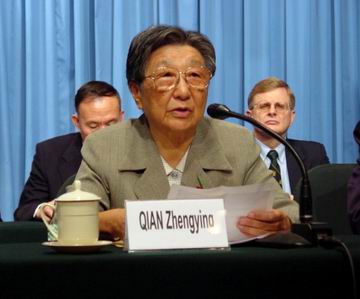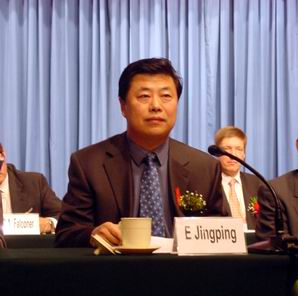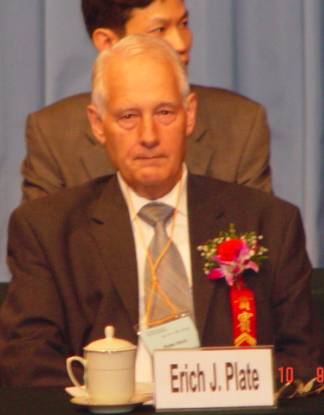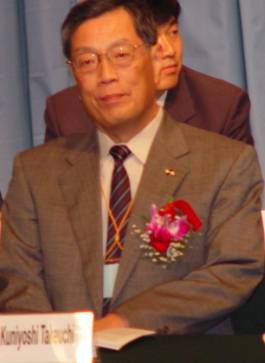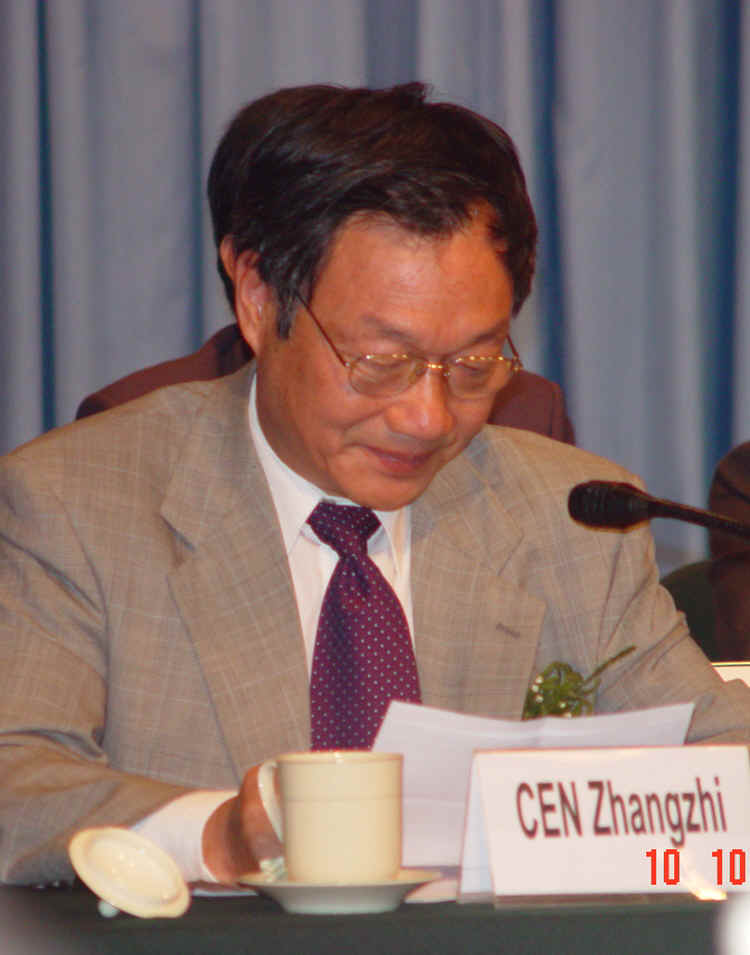|
¡¡ |
|||
¡¡ Opening Addresses Speech
By H.E. Mm. Qian Zhengying
Mr. Chairman, Ladies and Gentlemen: At the time when ¡°The Second International Symposium
on Flood Defense¡± is opening, on behalf of the advisory committee of the
symposium, please let me extend my warmest welcome to all the participants
abroad and at home. As it is known, water became one of five broad
themes mentioned by the World Summit on Sustainable Development held in
Johannesburg last week. Being an important part of water management, flood
control system plays an important role for the global sustainable
development. In recent years, flood disasters occurred
frequently all over the world, which have caused huge social and economic
losses, for example, the 1991 flood in Bangladesh, the 1993 flood in
Mississippi River in USA, the 1995 flood in Rhine River and the 1998
devastating flood in the Yangtze River in China etc. Although various
kinds of measures have been taken to avoid or mitigate flood disasters,
such as heavy investment on flood control construction, there is still an
obvious increasing tendency of the frequencies and magnitude of flooding.
During the mid August of this year, floods swept central and eastern
Europe and caused huge losses in Germany, Russia, Austria and the Czech
Republic. Floods also occurred in Yangtze River in the same period. China¡¯s
5000-years civilization is a history of Chinese people fighting against
flood and drought disasters. From of old, a Chinese legend called ¡°Da Yu
Zhi Shui¡± describes a tribal headman named ¡°DaYu¡±, who harnessed the
Yellow River with the philosophy of ¡°Guiding and dredging the river by
the regime of the river, bringing under control both the river and the
basin land together¡±. By looking back the history, we still can learn
something from this philosophy. Since the founding of the people¡¯s republic of
China in 1949, the Chinese government has led the people to develop water
resources on an unprecedented scale and great achievements attracting
worldwide attention have been made. Especially since 1998 great flooding
in the Yangtze River and the Songhua River, the central government poured
vast investment into the reinforcing or building flood-control infrastructure along China's
major rivers.
For the Yangtze River alone, some 30 billion
Chinese yuan (US$3.5 billion) was earmarked during the 1998-2002 period to
consolidate the major levees. So far, no major flood-related mishaps
occurred along the main levees of the Yangtze, therefore people and their
properties were prevented from flood, though the river¡¯s middle and
lower reaches was hit by flood crests with rather big discharges and high
water levels this year,. Flood is a
natural occurrence caused by abnormal climate, whereas flood disaster is
caused by land reclamation on the high-risk zone of floodplains. Three
phases can be set in the developing process of the relationship between
mankind and flood: first was in the agricultural society era, called
¡°damming water with earth¡±, which reflected a thought of passive
defending in a limited area. The second appeared in the industrial society
era, called ¡°man can conquer nature¡±, which reflected a thought of
comprehensive harnessing and actively controlling. Nowadays, we are facing
the third phase in this new knowledge information era, which can be called
¡°living with flood¡±, as the theme of this symposium. In a
densely populated country like China, it has been a historical reality
that mankind fighting against flood for a piece of land to survive. China
has totally about 1,000,000km2 alluvial river plains, on which
located the most prosperous land of the country, however, only with the
protection of the dikes and levees along the rivers, lakes and coastal
lines that people can survive and develop. The essence of flood prevention
is how to manage floods and rationally develop the 1,000,000km2
river plain to achieve the goal of living with floods. On these pieces of
land, located nearly half of the population, many important cities and
towns with rapidly increasing economy since China¡¯s opening to the
outside. It is noteworthy that while people make their effort on levee
construction, the space reserved for the passage or storage of floods
might be reduced at the same time; and while people developed water
resources works in the upper reaches, the relationship between water and
sediment might be changed and sedimentation in the downstream floodway
might occur. When a flood is too big for the channel to carry or store,
the levees would break and flooding appear. In recent years, the
phenomenon of low discharge but with rather high water level always
occurred during the flood season in the Yangtze River and the Yellow
River. It is because of the changes of the basin natural conditions and
further changes of the river flood process caused by the unreasonable
human activities. Therefore the improvement of strategies on flood control
and disaster mitigation has been gradually carried out, from ¡°fighting
against floods¡± in and out-of-order and untempered way to ¡°living with
floods¡± in an orderly and sustainable way; from mainly the structural
flood control system construction to a comprehensive flood control and
disaster mitigation system. The Second
International Symposium on Flood Defence held in Beijing brings our
Chinese participants a very good opportunity to exchange ideas and learn
experience from experts of other countries. I sincerely hope that the
symposium will help our friends from abroad to know more about the flood
control and water management in China, and our Chinese participants will
have a deep and comprehensive understanding of state-of-art theories and
technology state of art, and effective practices abroad. Let us work
together for the sustainable social and economic development with
sustainable water resources utilization. At last,
wish all the participants and our friends have a pleasant journey in
China. Thank you!
Distinguished
Guests, Ladies and Gentlemen: Today
is the opening of the second International Symposium of Flood Defense and
on behalf of the Ministry of Water Resources and the Headquarter of the
State Flood Control and Drought Relief of China, I sincerely wish to
extend my warm welcome to all the Guests! The
Symposium will undoubtedly improve the level of the solution of flood
disaster, for it has attached so many world famous experts and scholars
and will discuss the task of solution to the water-related disasters. The
regions that were threatened by flood, especially along the lower reach of
the rivers in China, have always been the elite areas where the population
is relatively large and the social wealth is relatively centralized and
has played a very important roll in the development of social economics.
As a result, the flood disasters of the rivers are regarded as the
¡°serious trouble¡± of our country. It
is the long-established ideal for our nation of reducing the water-related
disasters and ensuring the security of social development. From the time
that our ancestor Dayu had fought against the flood, we have strived for
it for over 4000 years. Obviously the brilliant ancient civilization and
the modernized construction have a close relationship with the great task. Since
the passes 50 years, our government and our people have made great efforts
to prevent the water-related disaster and ensure the social economic
development. Over 200,000- kilometer embankment, 80,000 reservoirs, and
100 flood detention districts have been constructed and as a result, the
flood defense system that can control the common flood has been achieved. In
the first 30 years in the 21st century, the population of China
will be 160 million, the rate of urbanization will be up to over 50percent
from 30 percent now, and the social wealth of the flood-threaten regions
will be more centralized. It will be a great issue for the social
continuous development of China for how to reduce the disaster of flood
and the relative consequences. The
successful experiences and deficiencies in history shows that, for such a
country as China that is facing great threaten of population, development
and environment, it is necessary but not sufficient and consummate to
control a certain measure of flood moderately through engineering measure.
After the flood in 1998,we are gradually coming to the agreement and
change on the following prime ideas: that is, Instead of attempting to
eliminate flood, it is advisable to endure some risks within measure to
realize the coordinated development of disaster-reduction and social
economics; Instead of preventing the violation of flood to people, it is
important to prevent the violation of we people to water at the same time;
Instead of focusing on the construction of flood defense project, it is
critical to attach importance to the non-engineering flood defense measure
,to insist on scientific management and to control water with law; Instead
of regarding flood totally as disaster, it is accepted that it also has
the function of providing resources and improving the ecological
environment; Instead of purely fighting against flood, it is wise to
reasonably adjust the relationship between people and flood when the life
security is ensured; Instead of purely preventing and draining flood, it
is effective to emphasizing on the complex administration of the flood
risk region at the same time. The
realization of these change is depend on many preconditions such as the
formation of concept on disaster reduction which is adapted to the new
position; the continuous innovation of disaster reduction theory; the
exploitation and exertion of new scientific disaster reduction technique;
the close cooperation of the research and the practice of
disaster-reduction; the continuous development of the research level and
group, and the international exchange and cooperation. Although
there are some differences in case of the situation of countries, many
countries, no matter the developed or developing countries, are facing the
embarrassment of water-related disasters.(For example, the flood in Europe
this year) They have many good points on the experiences, deficiencies,
ideas and techniques in flood-reduction practice for us to use for
reference. Actually, many ideas and techniques that we are using now, such
as the theory of continuous development, the harmonious coexistence
between human and nature, and the complex flood management and
decision-making supporting system, are all to some degree, learned from
others. All the ideas, theories and techniques that will benefit our
disaster-reduction career should be carefully studied, introduced and
absorbed into the research and practice of disaster reduction according as
our country condition to improve the development of our flood defense and
disaster reduction career. At the same time, we will set out our fruit to
the whole world to contribute to the international disaster reduction
career. It
is my great pleasure to see that, in these essays for exchange in this
Symposium, many experts and scholars are concerned of and discussed
China¡¯s flood problem and give out their ideas and advices. I hope that
here by this chance I can give my sincere thanks for them. It
is hopefully that experts and scholars could study more about China¡¯s
flood problem and give counsel for us, and also, the experts from China
pay more attention to that of other countries and the research trends of
international anti-flood and disaster-reduction, so that we could further
strengthen the exchange and cooperation, promote understanding and thus
make greater contribution to the development of the research. I
wish the Symposium a great success and all guests¡¯ good health. Thank you !
Ladies
and Gentlemen, It
is a pleasure to be again in this great city of Beijing, where the signs
of rapid progress into a new era are seen everywhere. And where it is most
appropriate to speak of water. Water has become one of the leading topics
of the beginning century. Water is the lifeblood of sustainable
development- no development can be sustainable if there is no or not
enough water. But neither can development be sustainable if it is
continuously endangered by extreme floods. Water supply stability is a
necessary condition, but so is safety against floods. We
seem to see an increasing threat from large floods to the development of
countries, as is made evident in the large flood events since the nineties
of last century: the large floods on the Rhine in 1993 and again in 1995,
the Mississippi flood of 1993, the floods on the Yangtse in China of 1998.
They were first indicators of what appears to be a change in the global
weather pattern: since then, South Africa and Mozambique in 1999, the
Mekong floods of 1999, 2000 and 2002, to name but a few: flood disasters
of ever increasing magnitude have struck almost all parts of the world. In
Germany we experienced the enormous once every few hundred year flood on
the Odra river in 1997, and the Elbe region has just suffered the worst
flood in history, with financial damage which might reach more than 20
Billion US$. In
response to these large floods we have to rethink our approach to flood
problems. We must get away from the concept of fighting the floods to the
concept of flood management. It is no longer possible to protect against
floods of all conceivable magnitudes, but we must learn to live with the
floods. This means that we have to develop methods to see flood protection
through technical means as one only of many possible approaches to flood
problems. Technical measures such as dikes and polders, non-technical
measures such as returning flood plains to the rivers, land improvement
measures such as reforestation are to be considered as part of a more
comprehensive flood plain development. Comprehensive flood plain
management is a task which must optimize the whole social, economic and
technical development, giving due regard to ecological considerations as
well - and which includes to be able to handle extreme floods and be
prepared for them. Prepared through good forecast and good warnings, as
well as through good planning of what to do when the floods cannot be
contained. Flood management has become a multiobjective process, with an
interdisciplinary scientific basis, involving engineers, and natural
scientists, and also contributions from legal, medical and social
sciences. But it is first of all an organizational and administrative
process, involving managers and administrators, and most importantly, it
must also involve the people, who might suffer from the flood. ¡¡ Speech By Prof. Kuniyoshi Takeuchi Your
Excellencies, Distinguished Delegates, Ladies and Gentlemen: On
behalf of International Association of Hydrological Sciences, I would like
to express my hearty congratulation to the successful opening of the 2nd
International Conference on Flood Defense. I appreciate and respect the
great efforts the Local Organizing Committee made for this excellent
planning and preparation. The
world is now in transition to a warmer climate. A number of extreme
meteorological phenomena have been experienced every year and everywhere.
Especially floods are occurring all over the world including European and
arid and semi-arid countries that have seldom experienced such extensive
floods before. This year again, a series of flood disasters have occurred
or have been occurring all over the world. Just a few examples of them
are, from preliminary reports of an NGO ¡°Rivers and Water¡± on 21 and
23 August issues: ・
In Hunan Province, since August 10, more
than 5 million people affected by floods. Especially in Dongting Lake, the
water elevation exceeded by 2 meters the warning height, and 600 000
people evacuated by August 22. ・
In Yunnan Province, from July 30 to
August 17, due to a devastating flood, 106 died and 72 missing, 27 000
affected and 13 000 evacuated. ・
In Europe, August floods killed at least
58 in Black Sea, Russia, 11 in Germany, 11 in Czech and 7 in Austria; 111
people altogether by August 21. By August 16, 300 000 evacuated, of which
200 000 in Czech and 130 000 in Germany. ・
In Nepal, since July 13, 424 died and
173 missing by floods and landslides. 32 000 lost houses and 250 000
affected. ・
In the Eastern Himalayan Foothills,
India, more than 15 million people were affected by flooding of 2.47
million acres of corn fields. ・
In Assam region, India, more than 109
died and more than 5.35 million people lost houses since July. On August
21, in Madhya Pradesh Province, a 125 year old dam collapsed and 75 people
missing. Ladies and gentlemen: They are just some examples of floods
this summer. They are serious but, in fact, nothing comparable with such
huge human losses occurred in 91, 94, 96 and 98 in China or 91 in
Bangladesh. We know that the devastating floods have been increasing and
intensifying since late 1980s. We know that the number of people died of
floods is more than any other disasters. We are now living in the world of
intensified climate variability. We have to defend ourselves by living
with floods. Yes, human being has been living with floods ever since our
birth. We can live with floods. The history shows the evidence. That is
the fact: Floods never destroyed civilization. All
four ancient civilizations of the world originated along the big rivers,
the Yellow Rivers one of them and the one still very prosperous. People
living in those four rivers suffered from floods very seriously. Yet the
civilization never got destroyed because of floods. Rather they invented
science, technology and efficient governance mechanism through living with
floods. Most of civilizations were destroyed because of salinization but
not by floods. Floods are a source of prosperity when they are properly
managed. Mankind is capable of living with floods. Ladies
and gentlemen: It
is especially meaningful to have this Conference in Beijing, near by the
Yellow River basin where Chinese people have been experiencing ¡°living
with floods¡± thousands of years. Let us mutually learn the way of flood
defense, utilizing the new opportunities available to us applied to new
form of society. With new science and technology and new societal needs,
we have to seek for a new relation with floods. The relation between
floods and society is a never-ending evolutional process. I
believe we have very fruitful discussions and a great success of the
Conference. Speech
By Prof. Hein T. C. van Stokkom Your Excellencies, Mister Chairman and members of the
Organising Committee, ladies and gentlemen, On behalf of the Ministry of Transport, Public
Works and Water management in the Netherlands I would like to extend a
warm welcome to all distinguished guests, delegates and participants of
this 2nd International Symposium on Flood Defence. I would like to
compliment the Government of the People's Republic of China and the
Organising Committee for facilitating and organising this symposium on
such an important and actual topic throughout the world. I am honoured to
address you at the beginning of this conference as a river and water
manager, but also as a citizen of the Netherlands, a highly populated
country which is criss-crossed by rivers and lies for about half of its
area under mean sea-level (up to 7 meters below). All over the world rivers and water are of vital
and existential importance to the world's ecosystem and the creatures
living on this planet. Rivers in many dimensions provide drinking water,
but also water and fertile soils for agriculture, provides energy, offer
opportunities for transport and economic usage. A tremendous amount of
people, especially in the densely populated and fertile deltaic parts of
rivers, benefit of these characteristics. At the same time, both water and rivers pose
threats to these populations if the water is too much, too little or too
polluted. Among these the issue "too much" has rightly gained
special interest over the last decade due to the increased number of
severe river floods in different parts of the world and the casualties,
damage and despair they caused. There is hardly any need to recall these
floods at this moment since last month large parts of China and Central
Europe suffered from flooding[1].
In the last decade floods occurred in Mozambique, USA, Germany, China and
India/Bangladesh. In the Netherlands we have dealt with a near flood in
1995 (rivers Rhine and Meuse) making the evacuation of 200.000 people
necessary. Respective governments took immediate action in
disaster mitigation, developed flood management strategies and made plans
for measures coping with flooding and preventing casualties and reducing
potential economic losses. As flood defence has been an issue over many,
many centuries it is nowadays, due to the characteristics of present
society, an important issue and leads to an intensified international
governmental and scientific co-operation. Considerable progress is achieved in this respect.
Following the Second World Water Forum (The Hague, 2000) international
co-operation is intensified. For instance, eight river basin organisations
signed a Declaration of Intent on the formation of Twinning Arrangements[2]
between these organisations. Furthermore, the Netherlands has signed
bilateral Memoranda of Understanding on Water Management with several
countries, including China, Argentina and Vietnam. During the Third World
Water Forum next year in Kyoto, Japan progress will be reported. Against this background I would like to take the
opportunity to make some remarks. Hopefully this stimulates thoughts and
discussions and possibly will add some issues to the international
scientific agenda. For centuries countries all over the world have
suffered of flood disasters and acted according to the socio-economic and
political context of the respective moment. The main strategy of flood
management was fighting the floods
and taming the rivers e.g. by river regulation and by constructing
higher dikes and dams. During the last (half) century, characterised by a
rapidly growing population, economic and industrial development, changes
in land-use, urbanisation and changing society values, this strategy
declined to be sufficient and adequate. Therefore, we have to adjust these traditional
flood management strategies. We will have to learn from the, at present
anticipated, "mistakes" of the past. We need thorough
understanding of the river systems and flood disaster characteristics
related to human activities, spatial use and evolutionary trends and
recognise that purely technical and engineering measures will be
insufficient. In this respect the impact and long-term effects of climate
change should be taken into account. Future flood management strategies
should include water regulation measures, reducing vulnerability (e.g. by
adequate maintenance of structures), adequate monitoring, forecasting and
early-warning systems, evacuation procedures and moreover focus on active
public awareness. Public awareness and support will provide the basis for
political decision making and respective funding of implementing the flood
management strategy and measures. But public awareness is also
indispensable in case of planned evacuation and controlled flooding. In implementing and operating this strategy it is
evident that issues like risk management, cross-border river basin
co-operation, scientific research, technology and education are of vital
importance. Depending on the different countries restructuring of the
river and water management institutions and governmental bodies involved
could be necessary. In developing such a strategy the entire river basin,
including catchment area and tributaries, is to be incorporated. In my
lecture I will address a strategy and approach more deeply applied to the
Netherlands. The challenge of such a future flood management
strategy is to work hand in hand with the river, taking advance of the
strengths and natural power of the river system. In stead of adjusting the
river to the desired use, we will have to adjust and tailor the spatial
planning, (economic) use and human behaviour to the river. I would
call such a strategy an integrated
sustainable flood management
strategy. This approach will cope with the flooding issue and,
moreover, challenge transportation technology and logistics, physical
planning concepts, building technology, dynamic river management, et
cetera. I stressed the importance of an adequate flood
management strategy for many countries and river basin authorities
throughout the world. The Netherlands recognises this importance and
emphasises the benefits of international co-operation between scientists
and authorities in order to provide our peoples flood protection,
opportunities for socio-economic development and a sustainable future.
Therefore, I am very pleased to announce on behalf of the Vice-Minister of
Transport, Public Works and Water Management that the Netherlands is
willing to host the Third International Conference on Flood Defence in the
Spring of 2005. I wish you a highly productive and inspiring
symposium. Thank you for your attention. Speech By Mr. Richard Reidinger
¡¡ |
||||
| Previous page | Next page | Home page | ¡¡ ¡¡ |
|

